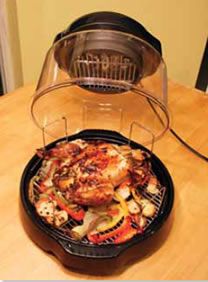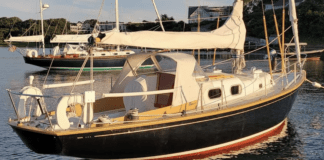
Photo by Theresa Nicholson
208
The galley may be the last place you’d expect to see new technologies, but our tour last year aboard the custom Fastwater 52 cat Ice Wars (Inside Practical Sailor, June 2011) introduced us to a new way of onboard cooking. Rather than a standard oven, Ice Wars was outfitted with only an infrared oven that was small enough to stow in a galley cupboard. Intrigued—and a little skeptical—we decided to have a go at using one of these new-age cookers to see whether it was a functional and practical galley tool.
The NuWave Pro Infrared Oven, manufactured by Hearthware Inc., is a compact, portable oven that cooks food via conduction, convection, and infrared heat. This triple combo method reduces cooking times and can broil, bake, roast, steam, grill, air-fry, and dehydrate food.
Conduction cooking applies heat directly to food, while convection cooks by circulating hot air evenly throughout an enclosed space. Infrared cooking uses radiant heat to penetrate the inside of food while also cooking the outside.
Infrared energy comprises frequencies that exist just below the red end of the visible light spectrum. This offers a unique benefit for cooking: When the energy strikes organic molecules (such as food), the molecules vibrate, creating heat. According to Hearthware, the NuWave uses 15 percent of the energy regular ovens use but can cook most recipes 50 percent faster. The NuWave uses patented heating rods and a 1,500-watt sheath heater that the maker claims can last up to 30 years; the rods are designed to never need replacement. Most conventional ovens use 3,400 watts of energy.
Practical Sailor tested the NuWave Pro, which came with an instruction manual, an extender ring kit, an instructional DVD, 25 recipe cards, and a cookbook. For testers who had never used a convection oven or infrared heat for cooking, the oven looked like a futuristic microwave from a sci-fi movie. Measuring 15.5 inches in diameter and 13.5 inches tall (6.5 inch by 12 inch cooking area), the 9-pound unit has a sturdy base that holds a removable liner pan and a clear, lightweight dome made of high-quality plastic that is FDA approved for cooking. A cooking rack rests on the liner pan, and the oven’s power head sits on top of the plastic dome. It contains the oven motor and fan, and features easy-to-use pushbutton oven controls.
Test Cooking and Taste Testing
Following maker instructions, testers cleaned the oven and pans twice, then allowed the empty oven to cook for 5 minutes at the default “high” temperature setting (about 350 degrees). The empty oven gave off a strong, plastic-like odor that permeated the area.
Testers then experimented with cooking hard-boiled eggs; the egg was hard boiled, with no water, after 10 minutes. The first recipe we tested was broiled potatoes: We added olive oil, herbs, and salt and pepper to sliced potatoes, then broiled them for 10 minutes per side. The potatoes came out crispy, non-greasy and appealingly brown on the outside, while cooked thoroughly and evenly through the center. The NuWave browns the surface of the food as if pan searing or frying—without having to add oil or continually turn the food.
Testers graduated to cooking a fresh, 4-pound chicken, stuffed with garlic and surrounded by potatoes, peppers, and onions. After cooking for 30 minutes on each side, the meat was nicely browned and crisped on the outside, while juicy and evenly cooked throughout. Testers were surprised that the food cooked according to recipe was neither bland nor mushy like most microwave recipes.
Testers also “baked” a breakfast casserole with ham, eggs, and potatoes; cinnamon-stick bread rolls; and banana bread. We were impressed by the number of recipes that could be tackled without too much effort, and found that the easy cooking method took a lot of guesswork out of the game. All recipes turned out better than expected, with a nicely browned, tasty exterior and a juicy, evenly cooked interior.
Unlike a typical onboard oven, which can turn a galley into an inferno, the confined cooking area never heated up while testers used the NuWave Pro Infrared Oven. The oven also was easy to clean, and all of the parts are machine washable, except the power head.
Bottom line: Cooking with the NuWave Pro was easy, the results were excellent, and it proved to be a very versatile appliance. For shoreside kitchen use, we would definitely recommend it, but it has limited practical use for cooking on most small and mid-sized cruising boats.
The oven’s plastic dome does not lock to the base, making it difficult to safely use the oven on any heel or in any sort of sea without some jury-rigging. While the NuWave Pro draws only 12.5 amps, its electrical cord is awkwardly short and challenging to work with. Also, the oven takes up a fair amount of counterspace, which most galleys are in short supply of. Its size and shape would also make it a challenge to stow on smaller boats. All that being said, the $120 NuWave Pro is a quality product, so those with larger galleys and cat-flat cooking conditions—or those who mostly cook at anchor—may want to consider the oven alternative. The $80 NuWave Mini oven, which we did not test, may be a better option as it has a smaller footprint (9-inch diameter) and its dome clips securely to its base.








































